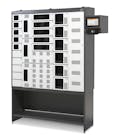This article originally appeared in the July 2013 issue of SD&I magazine.
Plagued by internal theft and an increasingly sophisticated organized retail crime (ORC) syndicate, big box, boutique and nearly every type of organization in between is increasingly turning to video, intrusion, electronic article surveillance (EAS) and other systems solutions to stop crime in its tracks or garner appropriate evidence to mitigate and prosecute losses.
According to a new study conducted by the Loss Prevention Research Council (LPRC) “CCTV in Retail 2012” commissioned by Axis Communications, retailers are migrating to IP video solutions at a rapid pace. The study found that nearly 64 percent of stores have some form of IP-connected surveillance system, more than double the number that said they were using network video solutions in a similar study conducted in 2010.
Of stores that still use analog-based surveillance systems, 43 percent of respondents said they had an IP migration strategy in place and another 21.4 percent said they would like to create a plan in the future. The most non-loss prevention analytic applications used by respondents were people counting (46.3 percent), followed by dwell time analysis (20 percent) and heat mapping (18.2 percent). Slightly more than 38 percent of respondents said they used video analytics to detect point-of-sale fraud.
Companies like Universal Surveillance Systems (USS), a systems solution provider in Rancho Cucamonga, Calif., that specializes in the market, retailers have become more focused and educated on the steps they can take to reduce their losses.
USS is a unique, total solutions provider that also specifies and manufactures an entire suite of products for its customers designed to thwart retail theft. The company recently unveiled new tools to prevent product theft—including the Scout X400 Public View Monitor with built-in DVR and multiple tamper alarms—at the National Retail Loss Prevention Conference in June 2013.
Gerald Becker, who is the director of Physical Security for USS, said that retailers in the past had been very slow to adopt new technologies, but as their losses mounted that thinking changed. “Retailers are starting to get hip—they are becoming more proactive rather than reactive and are bringing in new initiatives in the fight against organized retail crime and employee theft.”
Becker said that another reason the retail community is beginning to embrace systems solutions more is that now there are more open architecture, IP-based technologies and the use of video and other analytics reaches beyond loss prevention. “Physical security can do a myriad of things, like analyze traffic patterns, dwell times, choke points in a store and more, so it’s become more of an operational tool as a whole. Electronic article surveillance and RFID are now tying into video management systems and helping bring analytics in, such as analytics that analyze shrink, where product is moving, where thefts are occurring and other parts of day to day activity to assist in overall marketing efforts.”
Becker said Point of Sale integration is the big trend, allowing retailers to smartly analyze what’s going on there or ‘at the edge’ through recording devices, or public view monitors. “Public view monitors placed at the end cap incorporate multiple technologies, with tampering controls, recording and embedded DVRs.”
And ORC, he said, continues to be a big problem for retail organizations. “ORC evolves, just like technology. The retail syndicates get smart and they evolve with technology and it’s difficult to stay ahead of them.”
Becker said retailers have pain points, like Abercrombie & Fitch, a national retail store that is particular about aesthetics. “They don’t want holes in ceilings and want domes and other devices as discrete as possible.” For that retailer and others, USS designed a patented track lighting system called the StealthTracker where the camera mounts to the fixture and connects to a wireless network.
“Retailers are doing their homework; they have a younger management overall and are more IT centric and understand it and are embracing new technologies. I believe that in this vertical we will be moving to fully integrated systems within the next five to 10 years—a system that with one click everything will be on one system, such as access control, intrusion detection, video and analytics.
Ron Poulin, owner of Daytona Broadband LLC, a systems integration company based in South Daytona, Fla., works with retailers on providing point of sale systems and cash registers and wonders why such devices are not considered by many as security devices.
“In fact, a device (or system of devices) that holds your incoming cash, processes your credit card, gift card and debit card sales, provides reports to identify sales patterns and possible sales manipulation by cashiers/clerks, manages your inventory and purchase orders, collects employee time data, should be considered one of the most important of security devices relative to internal cash, product or time theft issues,” Poulin said. Along with a close affiliate; One Point POS in Orlando, Poulin deploys retail and small hospitality POS systems and cash register systems nationally through affiliations with national merchant services or POS software companies.
Solutions providers now have technology on their side to present new tools for loss prevention, marketing and accountability—and retailers are ready for all they have to offer.



